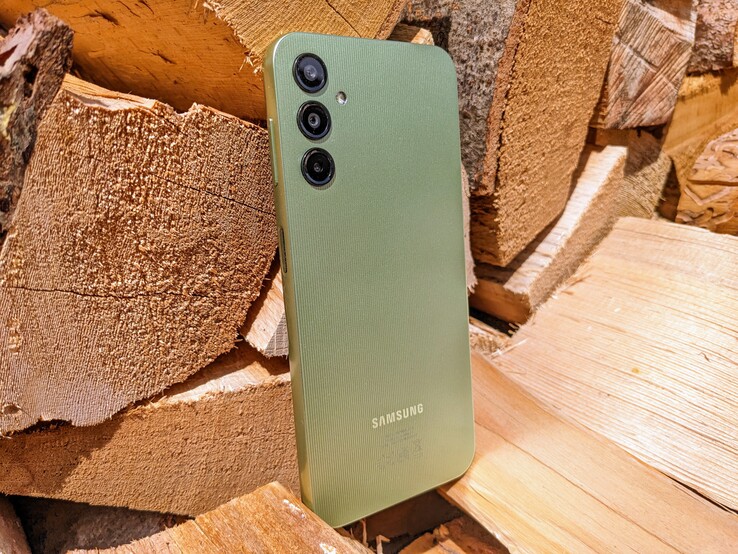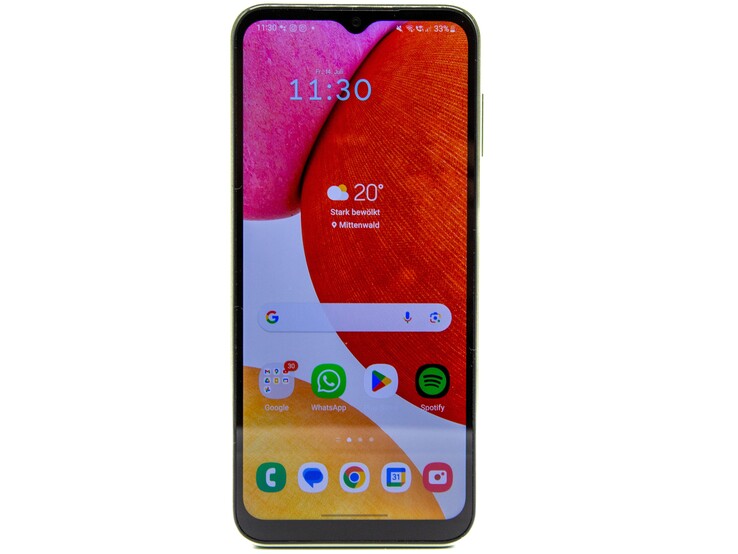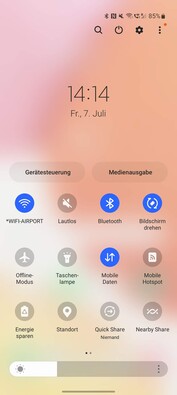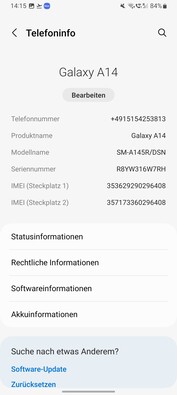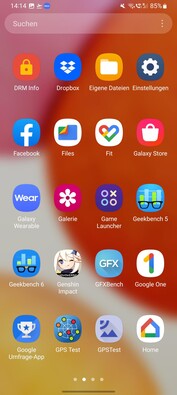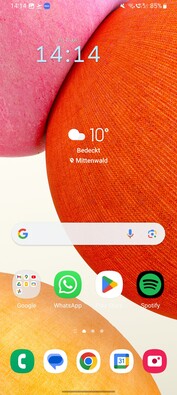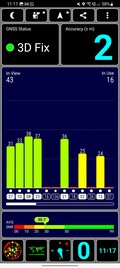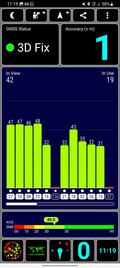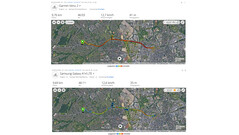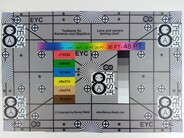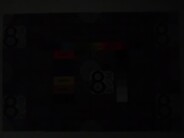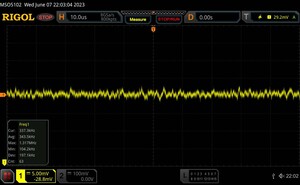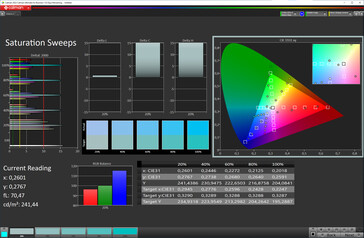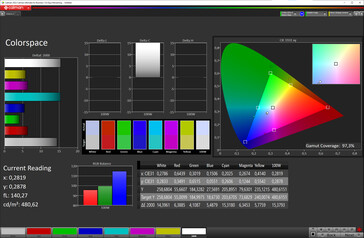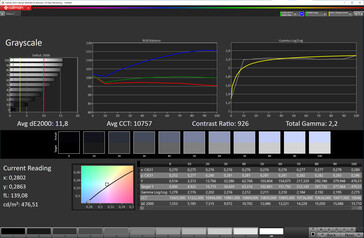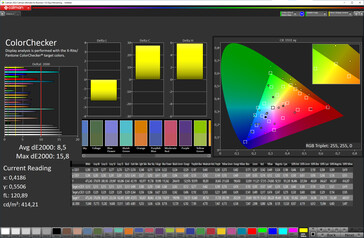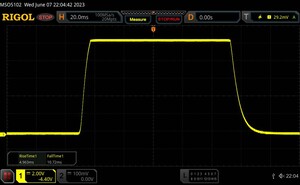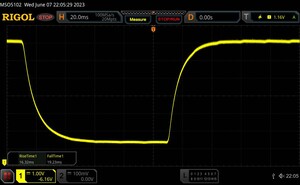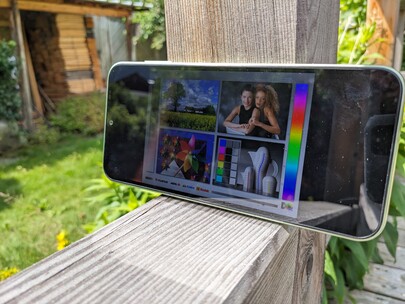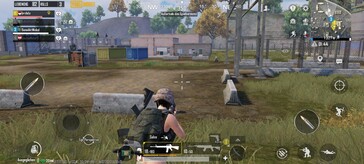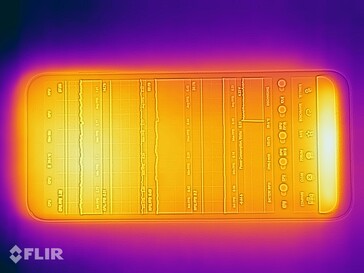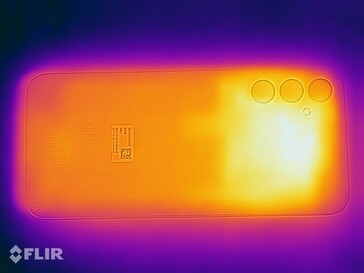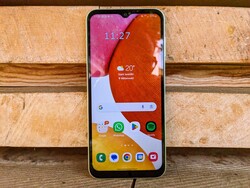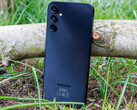Samsung Galaxy A14 LTE smartphone review - Is this an update?
The Galaxy A series stands for the midrange in Samsung smartphones, and the A14 is the entry-level model in this series. The manufacturer offers the device in a 5G and 4G version, but both devices not only differ in terms of their mobile communication standards but also in the processor, for example. Our test unit is the LTE version, which is the most affordable option to get a model of the A series.
The Galaxy A14 is also available in two storage versions with either 64 or 128 GB of storage capacity. In addition, the manufacturer offers the device in three colors: black, silver, and green. The MSRP for the 64 GB version is 179 Euros (~$199). While we praised the highly resolving display in the Galaxy A13 predecessor, we had problems with the low performance of the processor. Let's find out where Samsung made some changes in the successor.
Possible Competitors in Comparison
Rating | Date | Model | Weight | Drive | Size | Resolution | Price |
|---|---|---|---|---|---|---|---|
| 75.9 % v7 (old) | 07 / 2023 | Samsung Galaxy A14 LTE Helio G80, Mali-G52 MP2 | 201 g | 64 GB eMMC Flash | 6.60" | 2408x1080 | |
| 76.5 % v7 (old) | 05 / 2022 | Samsung Galaxy A13 4G Exynos 850, Mali-G52 MP1 | 195 g | 64 GB eMMC Flash | 6.60" | 2408x1080 | |
| 81 % v7 (old) | 07 / 2022 | Motorola Moto G52 SD 680, Adreno 610 | 169 g | 128 GB UFS 2.1 Flash | 6.60" | 2400x1080 | |
| 78.9 % v7 (old) | 11 / 2022 | Xiaomi Poco M5 Helio G99, Mali-G57 MP2 | 201 g | 128 GB UFS 2.2 Flash | 6.58" | 2408x1080 | |
| 80.1 % v7 (old) | 05 / 2023 | Xiaomi Redmi Note 12 4G SD 685, Adreno 610 | 188 g | 128 GB UFS 2.2 Flash | 6.67" | 2400x1080 |
Case - Samsung uses textured plastic
As usual in this price range, the case of the Samsung Galaxy A14 is made of plastic. The material is textured in the back, giving it more grip. The three camera bulges stick out from the back, making the phone wobble during inputs when it is placed on a table.
The smartphone's resistance to warping is good, and it doesn't produce any creaking noises when trying. The keys offer a good pressure point, but the volume rocker has some slight play in our test unit. The power button is easy to reach with the thumb, but you have to stretch your hand a lot in order to operate the volume rocker. We did not notice any scratches in the smartphone during the test period. Buyers of the A14 have to make do without an IP certification, and there is no apparent seal at all around the SIM card slot.
Equipment - Galaxy A14 with triple SIM slot
After the Galaxy A13 and A12 used the same SoC, Samsung provided the A14 with an upgrade, using the Mediatek Helio G80 as the CPU. It is accompanied by a Mali-G52 MP2 as graphics unit.
The 64-GB storage capacity of the test unit can be expanded by using a microSD card. In addition, the smartphone supports dual-SIM, accepting two physical SIM cards in a triple slot. Another positive point is Samsung also fitting a 3.5-mm audio port into the thick frame. The A14 also offers NFC, but the USB-C connection only supports the USB-2.0 standard.
microSD Card Reader
Samsung equipped the Galaxy A14 with a microSD card reader that is able to handle cards up to 1 TB and supports the exFAT standard. In the test with our Angelbird AV PRO V60 reference card, the A14 impresses with the fastest transfer rates in the class comparison. It is significantly faster than the A13 predecessor and more than twice as fast as the rest of our test field. The transfer rates are also stable.
| SD Card Reader - average JPG Copy Test (av. of 3 runs) | |
| Samsung Galaxy A14 LTE (Angelbird AV Pro V60) | |
| Samsung Galaxy A13 4G (Angelbird V60) | |
| Xiaomi Poco M5 (Angelbird V60) | |
| Xiaomi Redmi Note 12 4G (Angelbird V60) | |
| Motorola Moto G52 (Angelbird V60) | |
Cross Platform Disk Test (CPDT)
Software - Samsung promises two large Android updates
The Galaxy A14 is delivered with Android 13. Samsung adjusts the basic software with its own One UI in version 5.1. The manufacturer promises two large software updates for the A14 and four years of security updates. At the time of this test, the security patch is still from April 2023, so we assume a quarterly update period.
In the state of delivery, some third-party apps such as Facebook, Otto, or Market Guru are preinstalled, but they can all be uninstalled without any problems. On the other hand, some standard programs such as a calculator or stopwatch are missing, but you can of course install them using the Play Store.
In addition to the typical Google apps, Samsung also installs its own software, such as the Calendar or the Gallery, and the manufacturer also offers its own app store with the Galaxy Store. With the Game Launcher, the manufacturer also gives the option to collect all games in one place. The software can also block all the notifications during the game or record the gaming session.
Communication and GNSS - WiFi 5 and accurate locating
Samsung uses the WiFi 5 standard in the Galaxy A14. In the test with our Asus ROG Rapture GT-AXE11000 reference router, the WLAN connection proves to be stable. Even though the transfer rates aren't outstanding, they correspond to the price class and are at a good level compared to the other competitors in our test.
The Galaxy A14 supports all the usual frequency bands needed in Europe, but there is only a single version for the whole of Europe. The reception is inconspicuous in our test.
The A14 is able to shine with its satellite connection. Although the smartphone only uses a single-band connection for locating, it supports all the usual networks, including SBAS.
Locating succeeds quickly and accurately outdoors as well as indoors. On a bike tour where we also take the Garmin Venu 2 as a reference, the A14 impresses with its accurate recording of the route.
Telephone Functions and Voice Quality - Galaxy A14 works without a hitch
Samsung uses its own Phone app on the Galaxy A14. The software has a clear design and offers few surprises. WLAN calls are supported by the Galaxy A14.
The Galaxy A14 doesn't show any weaknesses in the voice quality. The voice of the A14 user is transferred clearly, and the voice reproduction of the earpiece is also good. The Galaxy A14 also masters calls via speaker phone without a hitch. Overall, the suppression of background noises could be better, since they are often also transferred.
Cameras - The main camera of the Galaxy A14 is good
Samsung uses a triple-camera setup on the back of the Galaxy A14. The star of the combo is clearly the 50-MP main camera. In good light conditions, the pictures are acceptable but lack a bit in sharpness. The color reproduction is rather pale. Movements lead to blurriness and streaking. But considering the MSRP, the performance offered by the main camera is good. The results of the HDR mode turn out positive. On the other hand, you should forgo using the digital zoom, since its results turn out very blurry.
It is good that Samsung also offers a Pro mode in the Galaxy A14: Optionally, ISO, shutter speed, aperture, focus, and white balance can be manually adjusted. Usually, the camera of the A14 uses pixel binning, but you can also take pictures in the full 50-MP resolution. In addition, the smartphone offers a panorama mode and various filter presets for arts and food.
For the macro mode, the A14 uses a separate 2-MP macro lens. Unfortunately, the results are rarely acceptable. To recognize some details, you definitely need a lot of light on the object. The results of the 5-MP ultrawide-angle lens turn out slightly better, but particularly the edges of the pictures are still blurry.
The 13-MP front camera takes good pictures, and portraits with blurry background also succeed reliably. A nice feature is the slider control allowing the user to adjust the degree of blurriness. You can even modify this afterwards in the gallery. Samsung forgoes an autofocus in the front camera, and none of the lenses offers an optical image stabilizer.
Recording videos is not one of the strengths of the Galaxy A14. With all of the lenses, the maximum resolution is FHD at 30 FPS. The autofocus of the main camera in the back works quickly and reliably, but you still need a steady hand, since otherwise the recordings can easily become blurry. When operating the camera, going through the modes, or switching between the camera and gallery, there are some clear stutters, and the operation isn't smooth. This corresponds to the A14's speed of operation, which is slow in general. But the shutter release still always works quickly.
Image comparison
Choose a scene and navigate within the first image. One click changes the position on touchscreens. One click on the zoomed-in image opens the original in a new window. The first image shows the scaled photograph of the test device.
HaseSeeUltraweitwinkel5x ZoomLow LightWe like the sharpness of the main camera under controlled light conditions. It only decreases toward the edges. On the other hand, the test image is hardly recognizable under very low light (1 Lux) and details are lost.
Samsung did a good job with the color adjustments. In bright light, the deviations turn out low, with the largest deviation in dark green color. But overall, the color reproduction turns out very homogenous.
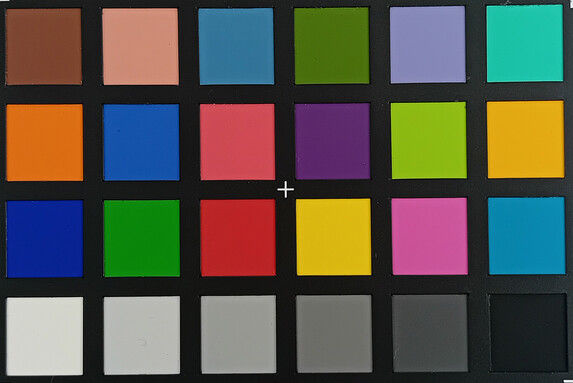

Accessories and Warranty - No charger with the Galaxy A14
The included accessories of the Galaxy A14 are very limited. Samsung only includes a USB cable (Type-C to Type-C), a quick-start manual, and a SIM tool with the smartphone. We look in vain for a charger or a protective case in the box of the Galaxy A14. The display also doesn't have a protective cover.
In Germany, Samsung offers a 24-month warranty for the A14. With Care+, Samsung also offers a warranty extension, also covering damage from drops or water. A year of Samsung Care+ costs 24 Euros (~$27) for the Galaxy A14, and with theft protection, it is 33 Euros (~$37) for one year.
Input Devices and Operation - A14 with stutters when typing
Samsung uses its own Samsung keyboard for typing. The software offers many adjustments to individualize the inputs. For inputs in landscape format, the keyboard is split, which facilitates typing on the large display.
The sliding characteristics of the touchscreen are good and there are no input errors in the test. However, the low system speed is even noticeable when typing, with inputs being displayed only with a delay and clearly stuttering keyboard animations.
You can unlock the Galaxy A14 either using a fingerprint reader in the power button or with 2D face recognition. Fingerprints are recognized reliably, but the device needs to think for a second before it is unlocked. The face recognition uses the front camera and is correspondingly insecure. In sufficient light, the face is recognized reliably, but the A14 isn't one of the fastest in the market in this regard.
Display - Large but dark LC panel in the Samsung
Even though the display of the Galaxy A14 has large bezels particularly above and below, it still impresses with a good resolution of 401 ppi. The PLS LCD display measures 6.6 inches and offers a refresh rate of 60 Hz with a scan rate of 117 Hz.
Looking at it by itself, the display of the Galaxy A14 offers a good impression, but a comparison with the competitors in this price class shows that others offer more for the money. The Motorola Moto G52 and Redmi Note 12 use an OLED panel, for example.
With the exception of the Poco M5, all the comparison devices have a brighter display with a better adjusted color reproduction. Even the panel of the Galaxy A13 predecessor achieved better results throughout all of our tests.
But at least the brightness distribution of the panel is fairly even. Although we measure some flickering of the display, since its frequency is extremely high at 343,500 Hz, we hardly expect any limitations.
| |||||||||||||||||||||||||
Brightness Distribution: 89 %
Center on Battery: 465 cd/m²
Contrast: 989:1 (Black: 0.47 cd/m²)
ΔE ColorChecker Calman: 8.5 | ∀{0.5-29.43 Ø4.77}
ΔE Greyscale Calman: 11.8 | ∀{0.09-98 Ø5}
97.3% sRGB (Calman 2D)
Gamma: 2.2
CCT: 10757 K
| Samsung Galaxy A14 LTE PLS, 2408x1080, 6.6" | Samsung Galaxy A13 4G PLS, 2408x1080, 6.6" | Motorola Moto G52 AMOLED, 2400x1080, 6.6" | Xiaomi Poco M5 IPS, 2408x1080, 6.6" | Xiaomi Redmi Note 12 4G AMOLED, 2400x1080, 6.7" | |
|---|---|---|---|---|---|
| Screen | 27% | 59% | 42% | 58% | |
| Brightness middle (cd/m²) | 465 | 553 19% | 655 41% | 400 -14% | 650 40% |
| Brightness (cd/m²) | 439 | 506 15% | 649 48% | 396 -10% | 658 50% |
| Brightness Distribution (%) | 89 | 87 -2% | 95 7% | 96 8% | 97 9% |
| Black Level * (cd/m²) | 0.47 | 0.44 6% | 0.27 43% | ||
| Contrast (:1) | 989 | 1257 27% | 1481 50% | ||
| Colorchecker dE 2000 * | 8.5 | 4.64 45% | 1.1 87% | 1.26 85% | 1.55 82% |
| Colorchecker dE 2000 max. * | 15.8 | 7.86 50% | 2.58 84% | 2.45 84% | 2.59 84% |
| Greyscale dE 2000 * | 11.8 | 5.6 53% | 1.7 86% | 1.5 87% | 1.8 85% |
| Gamma | 2.2 100% | 2.18 101% | 2.212 99% | 2.298 96% | 2.194 100% |
| CCT | 10757 60% | 8002 81% | 6557 99% | 6658 98% | 6316 103% |
* ... smaller is better
Screen Flickering / PWM (Pulse-Width Modulation)
| Screen flickering / PWM detected | 343500 Hz | ||
The display backlight flickers at 343500 Hz (worst case, e.g., utilizing PWM) . The frequency of 343500 Hz is quite high, so most users sensitive to PWM should not notice any flickering. In comparison: 53 % of all tested devices do not use PWM to dim the display. If PWM was detected, an average of 8086 (minimum: 5 - maximum: 343500) Hz was measured. | |||
The color adjustments of the Galaxy A14 are a bit weak. At 0.47cd/m², the black value is the highest in our test field, and in the Grayscale and colors, the deviations increase further. According to the Calman 2D measurement, the sRGB color space coverage lies at 97.3%.
Display Response Times
| ↔ Response Time Black to White | ||
|---|---|---|
| 15.68 ms ... rise ↗ and fall ↘ combined | ↗ 4.963 ms rise | |
| ↘ 10.72 ms fall | ||
| The screen shows good response rates in our tests, but may be too slow for competitive gamers. In comparison, all tested devices range from 0.1 (minimum) to 240 (maximum) ms. » 36 % of all devices are better. This means that the measured response time is better than the average of all tested devices (20.2 ms). | ||
| ↔ Response Time 50% Grey to 80% Grey | ||
| 35.55 ms ... rise ↗ and fall ↘ combined | ↗ 16.32 ms rise | |
| ↘ 19.23 ms fall | ||
| The screen shows slow response rates in our tests and will be unsatisfactory for gamers. In comparison, all tested devices range from 0.165 (minimum) to 636 (maximum) ms. » 49 % of all devices are better. This means that the measured response time is worse than the average of all tested devices (31.6 ms). | ||
The viewing angle stability of the Galaxy A14 display is decent. Its contents can be seen from various angles, but the brightness decreases significantly when viewing from the sides. The low maximum brightness of the panel becomes noticeable outside. In full sunlight, you have to protect the display from the sun with your hand, in order to still be able to see the contents.
Performance - The Galaxy A14 is lame
The performance of the system is one of the largest limitations of the Galaxy A14. Even though the Mediatek Helio G80 is a significant improvement compared to the Exynos 850 processor in the predecessor, the system speed is still slow. Even when closing some apps, there can be a wait and the animation can stutter. Opening apps also takes some time, even if the apps aren't very demanding.
This also becomes clear in the benchmark measurements, where the A14 does much better than the Galaxy A13 but still remains clearly behind the comparison devices with a Snapdragon 680, 685 or Mediatek Helio G99 in most tests. Only in the CrossMark and AIMark is the Galaxy A14 able to surpass one of the comparison devices. The Galaxy A14 also always interrupted the AnTuTu v9 benchmark.
While the smartphone is usable in everyday operation, this is accompanied by constant stutters and wait times.
| Geekbench 6.0 | |
| Single-Core | |
| Average of class Smartphone (n=1last 2 years) | |
| Xiaomi Redmi Note 12 4G | |
| Multi-Core | |
| Average of class Smartphone (n=1last 2 years) | |
| Xiaomi Redmi Note 12 4G | |
| UL Procyon AI Inference for Android - Overall Score NNAPI | |
| Average of class Smartphone (3769 - 81594, n=133, last 2 years) | |
| Xiaomi Poco M5 | |
| Xiaomi Redmi Note 12 4G | |
| Average Mediatek Helio G80 (3400 - 3992, n=3) | |
| Samsung Galaxy A14 LTE | |
| AImark - Score v3.x | |
| Average of class Smartphone (82 - 307528, n=120, last 2 years) | |
| Xiaomi Poco M5 | |
| Samsung Galaxy A14 LTE | |
| Average Mediatek Helio G80 (311 - 780, n=2) | |
| Xiaomi Redmi Note 12 4G | |
The graphics performance of the Galaxy A14 with the Mali G52 MP2 turns out better. The benchmark results show that the Samsung smartphone performs at the same level as the competitors. While the Poco M5 plays in its own league in terms of the performance, the A14 is able to place second in some of the 3D Mark measurements. An overview of the tests shows that the Galaxy A14 surpasses the predecessor and performs at a similar level as the comparison devices.
GFXBench (DX / GLBenchmark) 2.7: T-Rex Onscreen | 1920x1080 T-Rex Offscreen
GFXBench 3.0: on screen Manhattan Onscreen OGL | 1920x1080 1080p Manhattan Offscreen
GFXBench 3.1: on screen Manhattan ES 3.1 Onscreen | 1920x1080 Manhattan ES 3.1 Offscreen
GFXBench: on screen Car Chase Onscreen | 1920x1080 Car Chase Offscreen | on screen Aztec Ruins High Tier Onscreen | 2560x1440 Aztec Ruins High Tier Offscreen | on screen Aztec Ruins Normal Tier Onscreen | 1920x1080 Aztec Ruins Normal Tier Offscreen | 3840x2160 4K Aztec Ruins High Tier Offscreen
| 3DMark / Wild Life Extreme Unlimited | |
| Xiaomi Poco M5 | |
| Samsung Galaxy A14 LTE | |
| Xiaomi Redmi Note 12 4G | |
| Motorola Moto G52 | |
| 3DMark / Wild Life Extreme | |
| Xiaomi Poco M5 | |
| Samsung Galaxy A14 LTE | |
| Samsung Galaxy A13 4G | |
| Xiaomi Redmi Note 12 4G | |
| Motorola Moto G52 | |
| 3DMark / Wild Life Unlimited Score | |
| Xiaomi Poco M5 | |
| Samsung Galaxy A14 LTE | |
| Xiaomi Redmi Note 12 4G | |
| Samsung Galaxy A13 4G | |
| Motorola Moto G52 | |
| 3DMark / Wild Life Score | |
| Xiaomi Poco M5 | |
| Samsung Galaxy A14 LTE | |
| Xiaomi Redmi Note 12 4G | |
| Samsung Galaxy A13 4G | |
| Motorola Moto G52 | |
| 3DMark / Sling Shot Extreme (Vulkan) Unlimited Physics | |
| Xiaomi Poco M5 | |
| Xiaomi Redmi Note 12 4G | |
| Motorola Moto G52 | |
| Samsung Galaxy A14 LTE | |
| Samsung Galaxy A13 4G | |
| 3DMark / Sling Shot Extreme (Vulkan) Unlimited Graphics | |
| Xiaomi Poco M5 | |
| Xiaomi Redmi Note 12 4G | |
| Motorola Moto G52 | |
| Samsung Galaxy A14 LTE | |
| Samsung Galaxy A13 4G | |
| 3DMark / Sling Shot Extreme (Vulkan) Unlimited | |
| Xiaomi Poco M5 | |
| Xiaomi Redmi Note 12 4G | |
| Motorola Moto G52 | |
| Samsung Galaxy A14 LTE | |
| Samsung Galaxy A13 4G | |
| 3DMark / Sling Shot Extreme (ES 3.1) Unlimited Physics | |
| Xiaomi Poco M5 | |
| Samsung Galaxy A14 LTE | |
| Xiaomi Redmi Note 12 4G | |
| Motorola Moto G52 | |
| Samsung Galaxy A13 4G | |
| 3DMark / Sling Shot Extreme (ES 3.1) Unlimited Graphics | |
| Xiaomi Poco M5 | |
| Xiaomi Redmi Note 12 4G | |
| Motorola Moto G52 | |
| Samsung Galaxy A14 LTE | |
| Samsung Galaxy A13 4G | |
| 3DMark / Sling Shot Extreme (ES 3.1) Unlimited | |
| Xiaomi Poco M5 | |
| Xiaomi Redmi Note 12 4G | |
| Motorola Moto G52 | |
| Samsung Galaxy A14 LTE | |
| Samsung Galaxy A13 4G | |
| GFXBench (DX / GLBenchmark) 2.7 / T-Rex Onscreen | |
| Xiaomi Poco M5 | |
| Xiaomi Redmi Note 12 4G | |
| Samsung Galaxy A14 LTE | |
| Motorola Moto G52 | |
| Samsung Galaxy A13 4G | |
| GFXBench (DX / GLBenchmark) 2.7 / T-Rex Offscreen | |
| Xiaomi Poco M5 | |
| Xiaomi Redmi Note 12 4G | |
| Motorola Moto G52 | |
| Samsung Galaxy A14 LTE | |
| Samsung Galaxy A13 4G | |
| GFXBench 3.0 / Manhattan Onscreen OGL | |
| Xiaomi Poco M5 | |
| Samsung Galaxy A14 LTE | |
| Xiaomi Redmi Note 12 4G | |
| Motorola Moto G52 | |
| Samsung Galaxy A13 4G | |
| GFXBench 3.0 / 1080p Manhattan Offscreen | |
| Xiaomi Poco M5 | |
| Xiaomi Redmi Note 12 4G | |
| Samsung Galaxy A14 LTE | |
| Motorola Moto G52 | |
| Samsung Galaxy A13 4G | |
| GFXBench 3.1 / Manhattan ES 3.1 Onscreen | |
| Xiaomi Poco M5 | |
| Xiaomi Redmi Note 12 4G | |
| Motorola Moto G52 | |
| Samsung Galaxy A14 LTE | |
| Samsung Galaxy A13 4G | |
| GFXBench 3.1 / Manhattan ES 3.1 Offscreen | |
| Xiaomi Poco M5 | |
| Xiaomi Redmi Note 12 4G | |
| Motorola Moto G52 | |
| Samsung Galaxy A14 LTE | |
| Samsung Galaxy A13 4G | |
| GFXBench / Car Chase Onscreen | |
| Xiaomi Poco M5 | |
| Xiaomi Redmi Note 12 4G | |
| Samsung Galaxy A14 LTE | |
| Motorola Moto G52 | |
| Samsung Galaxy A13 4G | |
| GFXBench / Car Chase Offscreen | |
| Xiaomi Poco M5 | |
| Samsung Galaxy A14 LTE | |
| Xiaomi Redmi Note 12 4G | |
| Motorola Moto G52 | |
| Samsung Galaxy A13 4G | |
| GFXBench / Aztec Ruins High Tier Onscreen | |
| Xiaomi Poco M5 | |
| Xiaomi Redmi Note 12 4G | |
| Motorola Moto G52 | |
| Samsung Galaxy A14 LTE | |
| Samsung Galaxy A13 4G | |
| GFXBench / Aztec Ruins High Tier Offscreen | |
| Xiaomi Poco M5 | |
| Xiaomi Redmi Note 12 4G | |
| Samsung Galaxy A14 LTE | |
| Samsung Galaxy A13 4G | |
| Motorola Moto G52 | |
| GFXBench / Aztec Ruins Normal Tier Onscreen | |
| Xiaomi Poco M5 | |
| Motorola Moto G52 | |
| Xiaomi Redmi Note 12 4G | |
| Samsung Galaxy A14 LTE | |
| Samsung Galaxy A13 4G | |
| GFXBench / Aztec Ruins Normal Tier Offscreen | |
| Xiaomi Poco M5 | |
| Xiaomi Redmi Note 12 4G | |
| Samsung Galaxy A14 LTE | |
| Samsung Galaxy A13 4G | |
| Motorola Moto G52 | |
| GFXBench / 4K Aztec Ruins High Tier Offscreen | |
| Xiaomi Poco M5 | |
| Xiaomi Redmi Note 12 4G | |
| Samsung Galaxy A14 LTE | |
The browser benchmarks paint a similar picture. The Galaxy A14 doesn't show any weaknesses here, always remaining in the center of the test field. In everyday operation, the performance while web surfing is inconspicuous. Web pages are loaded quickly, and smooth scrolling is also possible.
| Jetstream 2 - 2.0 Total Score | |
| Average of class Smartphone (23.8 - 387, n=148, last 2 years) | |
| Xiaomi Redmi Note 12 4G (Chrome 113) | |
| Xiaomi Poco M5 (Chrome 107) | |
| Motorola Moto G52 (Chrome 103) | |
| Samsung Galaxy A14 LTE (Chrome 114) | |
| Average Mediatek Helio G80 (29 - 40, n=8) | |
| Samsung Galaxy A13 4G (Chrome 101) | |
| Speedometer 2.0 - Result 2.0 | |
| Average of class Smartphone (15.2 - 643, n=120, last 2 years) | |
| Xiaomi Redmi Note 12 4G (Chrome 113) | |
| Motorola Moto G52 (Chrome 103) | |
| Samsung Galaxy A14 LTE (Chrome 114) | |
| Average Mediatek Helio G80 (21.8 - 32, n=8) | |
| Xiaomi Poco M5 (Chome 107) | |
| Samsung Galaxy A13 4G (Chome 101) | |
| WebXPRT 4 - Overall | |
| Average of class Smartphone (27 - 306, n=144, last 2 years) | |
| Xiaomi Redmi Note 12 4G (Chrome 113) | |
| Average Mediatek Helio G80 (44 - 45, n=2) | |
| Samsung Galaxy A14 LTE (Chrome 114) | |
| Xiaomi Poco M5 (Chrome 107) | |
| WebXPRT 3 - Overall | |
| Average of class Smartphone (38 - 380, n=30, last 2 years) | |
| Xiaomi Poco M5 (Chrome 107) | |
| Xiaomi Redmi Note 12 4G (Chrome 113) | |
| Motorola Moto G52 (Chrome 103) | |
| Samsung Galaxy A14 LTE (Chrome 114) | |
| Average Mediatek Helio G80 (43 - 60, n=7) | |
| Samsung Galaxy A13 4G (Chrome 101) | |
| Octane V2 - Total Score | |
| Average of class Smartphone (2228 - 126661, n=195, last 2 years) | |
| Xiaomi Poco M5 (Chrome 107) | |
| Xiaomi Redmi Note 12 4G (Chrome 113) | |
| Motorola Moto G52 (Chrome 103) | |
| Samsung Galaxy A14 LTE (Chrome 114) | |
| Average Mediatek Helio G80 (10432 - 12744, n=9) | |
| Samsung Galaxy A13 4G (Chrome 101) | |
| Mozilla Kraken 1.1 - Total | |
| Samsung Galaxy A13 4G (Chrome 101) | |
| Average Mediatek Helio G80 (3227 - 4076, n=8) | |
| Samsung Galaxy A14 LTE (Chrome 114) | |
| Motorola Moto G52 (Chrome 103) | |
| Xiaomi Redmi Note 12 4G (Chrome 113) | |
| Xiaomi Poco M5 (Chrome 107) | |
| Average of class Smartphone (257 - 28190, n=155, last 2 years) | |
* ... smaller is better
On the other hand, Samsung cut some corners in the storage. Our test unit of the Galaxy A14 only offers 64 GB of storage, 17.3 GB of which are occupied in the state of delivery. But at least, the A14 includes the option of storage expansion via microSD card.
The storage used here is affordable eMMC storage, which is also clearly apparent when analyzing the read and write speeds. Compared to the predecessor, we notice that the storage in the A14 is even slightly slower. But the differences become drastic with the comparison devices. The results of the Moto G52, Poco M5, and Redmi Note 12 are about three times faster when reading large files.
| Samsung Galaxy A14 LTE | Samsung Galaxy A13 4G | Motorola Moto G52 | Xiaomi Poco M5 | Xiaomi Redmi Note 12 4G | Average 64 GB eMMC Flash | Average of class Smartphone | |
|---|---|---|---|---|---|---|---|
| AndroBench 3-5 | 32% | 164% | 317% | 289% | -12% | 611% | |
| Sequential Read 256KB (MB/s) | 298.69 | 308.5 3% | 893.44 199% | 976.4 227% | 954.87 220% | 277 ? -7% | 2246 ? 652% |
| Sequential Write 256KB (MB/s) | 200.17 | 236.8 18% | 503.56 152% | 870.7 335% | 709.51 254% | 178.4 ? -11% | 1882 ? 840% |
| Random Read 4KB (MB/s) | 55.9 | 104.4 87% | 98.99 77% | 247.6 343% | 261.09 367% | 60.7 ? 9% | 298 ? 433% |
| Random Write 4KB (MB/s) | 55.86 | 67.3 20% | 182.92 227% | 257.8 362% | 231.57 315% | 33.8 ? -39% | 346 ? 519% |
Games - Galaxy A14 with low frame rates
Despite the low system performance, playing games on the Galaxy A14 is still possible. Even more demanding games such as PUBG Mobile are playable, but the highest graphics level you can select is HD. Once the game is loaded and cards and other resources are downloaded, you can play the game smoothly. However, measurements with GameBench show that the frame rates turn out low. It hardly makes any difference whether you select the HD or Balanced setting.
The frame rates are 17.6 and 18.5 FPS respectively on average. In simpler games such as Dead Trigger 2, the frame rate is higher, but stable frame rates aren't reached even in this game. In addition, the recordings show that there are some frame drops that are clearly noticeable as stutters from time to time.
Emissions - Low heat and good sound with the A14
Temperatures - The Samsung stays mostly cool
In everyday operation, the Galaxy A14 stays pleasantly cool, and we measure a temperature of 28.9 °C (84 °F), which is lower than the class average. If you put some load on the smartphone, for example when gaming or running other demanding programs, it becomes significantly warmer, particularly in the area of the camera.
We measure a maximum temperature of 40.3 °C (104.5 °F) in that area. With this, the smartphone still is comfortably usable without becoming unpleasantly warm. The stress test shows that the performance of the smartphone is hardly throttled under load. While the system runs stably, a look at the other competitors shows that things can also be done better in this performance class.
(+) The maximum temperature on the upper side is 37.6 °C / 100 F, compared to the average of 35.2 °C / 95 F, ranging from 21.9 to 247 °C for the class Smartphone.
(±) The bottom heats up to a maximum of 40.3 °C / 105 F, compared to the average of 34 °C / 93 F
(+) In idle usage, the average temperature for the upper side is 28.9 °C / 84 F, compared to the device average of 32.9 °C / 91 F.
3DMark Wild Life Stress Test
| 3DMark | |
| Wild Life Stress Test Stability | |
| Motorola Moto G52 | |
| Xiaomi Redmi Note 12 4G | |
| Samsung Galaxy A13 4G | |
| Xiaomi Poco M5 | |
| Samsung Galaxy A14 LTE | |
| Samsung Galaxy A14 LTE | |
| Wild Life Extreme Stress Test | |
| Xiaomi Redmi Note 12 4G | |
| Xiaomi Poco M5 | |
| Samsung Galaxy A13 4G | |
| Samsung Galaxy A14 LTE | |
| Motorola Moto G52 | |
Speaker - A good mono speaker in the Samsung
Even though the Samsung Galaxy A14 only possesses a mono speaker, that delivers a solid performance. At 90.7 dB, it can get attractively loud without there being any vibrations in the case. The sound is balanced and particularly the mids are reproduced linearly. The highs are slightly too emphasized, while - as typical for this class - the low frequencies or even bass sounds are lacking almost completely.
It is positive that Samsung continues to equip its smartphone with an audio port. The signal-to-noise ratio is a decent 78.78 dBFS. Connecting Bluetooth headphones also works without any problems in the test. The A14 supports standard codecs such as SBC, AAC, aptX, LDAC, and SSC, but AptX HD, Adaptive, TWAS+ and LC3 are missing.
Samsung Galaxy A14 LTE audio analysis
(+) | speakers can play relatively loud (90.7 dB)
Bass 100 - 315 Hz
(-) | nearly no bass - on average 27.8% lower than median
(+) | bass is linear (4.9% delta to prev. frequency)
Mids 400 - 2000 Hz
(±) | reduced mids - on average 7.3% lower than median
(+) | mids are linear (6.4% delta to prev. frequency)
Highs 2 - 16 kHz
(±) | higher highs - on average 9.6% higher than median
(+) | highs are linear (2.5% delta to prev. frequency)
Overall 100 - 16.000 Hz
(±) | linearity of overall sound is average (23.5% difference to median)
Compared to same class
» 53% of all tested devices in this class were better, 8% similar, 39% worse
» The best had a delta of 11%, average was 35%, worst was 134%
Compared to all devices tested
» 70% of all tested devices were better, 6% similar, 24% worse
» The best had a delta of 4%, average was 24%, worst was 134%
Xiaomi Redmi Note 12 4G audio analysis
(±) | speaker loudness is average but good (81.3 dB)
Bass 100 - 315 Hz
(-) | nearly no bass - on average 26.5% lower than median
(±) | linearity of bass is average (12% delta to prev. frequency)
Mids 400 - 2000 Hz
(±) | reduced mids - on average 6.3% lower than median
(±) | linearity of mids is average (12.1% delta to prev. frequency)
Highs 2 - 16 kHz
(+) | balanced highs - only 3.4% away from median
(±) | linearity of highs is average (7.7% delta to prev. frequency)
Overall 100 - 16.000 Hz
(±) | linearity of overall sound is average (22.8% difference to median)
Compared to same class
» 50% of all tested devices in this class were better, 6% similar, 44% worse
» The best had a delta of 11%, average was 35%, worst was 134%
Compared to all devices tested
» 67% of all tested devices were better, 6% similar, 28% worse
» The best had a delta of 4%, average was 24%, worst was 134%
Battery Life - Large battery but meagre battery life in the A14
Power Consumption
Unfortunately, the Mediatek Helio G80 doesn't compensate for its low performance with a very low power consumption. Even though the SoC isn't really power hungry either, the Snapdragon processors in the comparison devices are more efficient. This is less due to any configuration by Samsung but more to the general consumption of the chip, as a look at the average values of all devices using this SoC shows.
While the power consumption under load is at the same level as that of the comparison devices, particularly the consumption during regular operation is fairly high at an average of 2.31 watts.
| Off / Standby | |
| Idle | |
| Load |
|
Key:
min: | |
| Samsung Galaxy A14 LTE 5000 mAh | Samsung Galaxy A13 4G 5000 mAh | Motorola Moto G52 5000 mAh | Xiaomi Poco M5 5000 mAh | Xiaomi Redmi Note 12 4G 5000 mAh | Average Mediatek Helio G80 | Average of class Smartphone | |
|---|---|---|---|---|---|---|---|
| Power Consumption | 14% | 30% | 9% | 16% | -3% | -14% | |
| Idle Minimum * (Watt) | 0.89 | 0.9 -1% | 0.8 10% | 0.9 -1% | 0.8 10% | 1.025 ? -15% | 0.847 ? 5% |
| Idle Average * (Watt) | 2.31 | 1.6 31% | 1.1 52% | 1.3 44% | 1 57% | 2.04 ? 12% | 1.446 ? 37% |
| Idle Maximum * (Watt) | 2.34 | 2.1 10% | 1.5 36% | 1.9 19% | 1.5 36% | 2.35 ? -0% | 1.63 ? 30% |
| Load Average * (Watt) | 4.11 | 3.6 12% | 2.9 29% | 4.6 -12% | 4.8 -17% | 4.18 ? -2% | 6.95 ? -69% |
| Load Maximum * (Watt) | 6.46 | 5.3 18% | 5 23% | 6.8 -5% | 6.7 -4% | 6.95 ? -8% | 11.3 ? -75% |
* ... smaller is better
Power Consumption: Geekbench (150 cd/m²)
Power Consumption: GFXBench (150 cd/m²)
Battery Life
An analysis of the power consumption also gives some ideas about the battery life. The high basic consumption leads to the maximum battery life being rather low at 19.5 hours in our test. But at least the Galaxy A14 lasts for almost 15 hours in the realistic web surfing test, approximately reaching the values of the competitors. Under full load, the Samsung Galaxy A14 lasts for 5 hours and 48 minutes.
In everyday operation, the battery life of the smartphone is better than expected. This is mainly due to the large 5,000-mAh battery and a low standby power consumption. As long as you don't play any games, the smartphone can also be used for a day and a half or two days before you have to recharge it again.
The Galaxy A14 takes its time to recharge. Since the smartphone doesn't include a charger, we tried out several different chargers, but that didn't make much of a difference in terms of the charging times. If the smartphone battery is completely empty, it takes about 2.5 hours to fully recharge it.
| Samsung Galaxy A14 LTE 5000 mAh | Samsung Galaxy A13 4G 5000 mAh | Motorola Moto G52 5000 mAh | Xiaomi Poco M5 5000 mAh | Xiaomi Redmi Note 12 4G 5000 mAh | |
|---|---|---|---|---|---|
| Battery runtime | 27% | 37% | 32% | 10% | |
| Reader / Idle (h) | 19.5 | 36.1 85% | 36.4 87% | 41.7 114% | 25.2 29% |
| H.264 (h) | 17.4 | 17.6 1% | 21.2 22% | 18.1 4% | 23.4 34% |
| WiFi v1.3 (h) | 14.9 | 14.4 -3% | 18.4 23% | 15.3 3% | 12 -19% |
| Load (h) | 5.8 | 7.3 26% | 6.6 14% | 6.1 5% | 5.5 -5% |
Pros
Cons
Verdict - Limited improvements in the A13
With the Samsung Galaxy A13 predecessor, we praised the high-resolution display and complained about the weak processor. Even though Samsung finally made some improvements in the performance, the Galaxy A14 still isn't really fast by any means. This not only becomes noticeable in the comparison with other devices of this price class but also in everyday operation with noticeable wait times and stutters. The slow eMMC storage surely also plays a part in the slow system speed.
While the display is okay for this price class, other manufacturers such as Motorola or Redmi equip their smartphones with OLED panels with 90 or even 120 Hz for the same price. In addition, the Samsung display doesn't get very bright.
On the other hand, the Galaxy A14 deserves some praise for its main camera. Under good light conditions, it takes beautiful pictures, only the sharpness could be slightly better. However, the ultrawide-angle and macro lenses are more like ornamental additions. What also deserves some praise is the update support with two large Android version updates and four years of security patches. With this, Samsung is unique in this price class. Additionally, the Galaxy A14 already arrives with Android 13.
For the price, the Samsung Galaxy A14 isn't a bad smartphone, but other manufacturers offer significantly higher quality equipment.
Those who prefer OLED panels with high refresh rates should alternatively take a look at the Motorola Moto G52 or Redmi Note 12 4G. Both of those smartphones also offer a higher performance. The Poco M5 offers even more computing power. If it has to be a Samsung smartphone, the 5G version of the Galaxy A14 is also worth a consideration, since it brings faster storage and a more powerful SoC.
Price and Availability
The US Samsung online shop only carries the 5G 64 GB version, which is available for ~$200. Amazon also offers the international Galaxy A14 4G version starting from around $138, with the 128 GB model costing ~$145.
Samsung Galaxy A14 LTE
- 07/17/2023 v7 (old)
Benedikt Winkel
Transparency
The selection of devices to be reviewed is made by our editorial team. The test sample was provided to the author as a loan by the manufacturer or retailer for the purpose of this review. The lender had no influence on this review, nor did the manufacturer receive a copy of this review before publication. There was no obligation to publish this review. As an independent media company, Notebookcheck is not subjected to the authority of manufacturers, retailers or publishers.
This is how Notebookcheck is testing
Every year, Notebookcheck independently reviews hundreds of laptops and smartphones using standardized procedures to ensure that all results are comparable. We have continuously developed our test methods for around 20 years and set industry standards in the process. In our test labs, high-quality measuring equipment is utilized by experienced technicians and editors. These tests involve a multi-stage validation process. Our complex rating system is based on hundreds of well-founded measurements and benchmarks, which maintains objectivity. Further information on our test methods can be found here.


